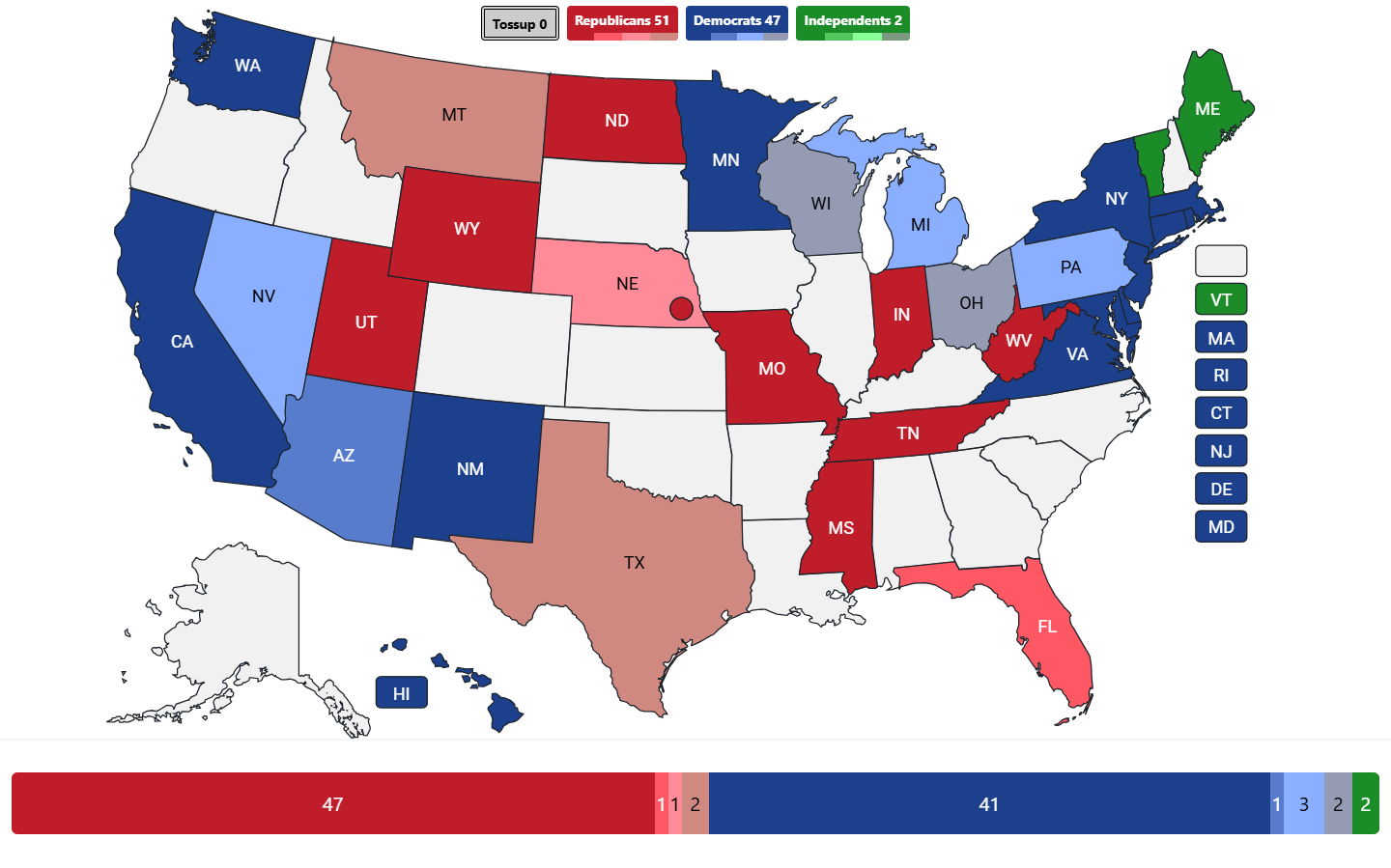Of course, the presidential race is not the only contest to watch on Election Day. The ability of the next president to be able to build a Cabinet effectively, appoint judges to the Supreme Court and other courts, and pass legislation will rely on whether or not their party controls the Senate.
In this election cycle, the 33 Class One Senate seats are up for election, in addition to a special election in Nebraska’s other Senate seat. 19 Democratic-held seats, 11 Republican-held seats, and 4 independent-held (all of whom caucus with the Democrats) seats are up for grabs. The map is highly unfavorable to the Democrats, as three of their seats are in states Donald Trump won in 2016 and 2020, while an additional four other seats are in states Donald Trump won in 2016 but not in 2020. Not a single Republican-held seat is up for election in any state won by Democrats in 2016 or 2020.
My prediction of the Senate elections this year. Made with YAPMS.
Considering these odds, we give the Republicans a 70% chance of winning a majority in the Senate, in contrast to the Democrats’ 30% chance. In our opinion, they will hold 51 seats to the Democrats’ (and their independent colleagues’) 49 seats. We’ll break down the competitive seats to watch on Election Day, and how we came to this prediction.
Montana and West Virginia
What do these two states have in common? Both were won by landslide margins by Donald Trump in 2016 and 2020, while simultaneously sending Democrats to the Senate in 2018.
Now, it appears likely that Democrats will lose these seats. Joe Manchin, the outgoing Senator from West Virginia who left the Democratic Party earlier this year but still chooses to caucus with Senate Democrats, is foregoing a third full term. Popular Republican governor Jim Justice is likely to flip this seat into the Republican column due to the lack of a strong Democratic opponent. We rate this race a Safe Republican Flip.
Montana Senate Republican candidate Tim Sheehy. Source: Bloomberg via Getty Images
On the other side of the country, three-term Senator Jon Tester continues to struggle to defend his seat against Republican candidate Tim Sheehy, who has led in many recent polls, often by more than 5 points. While Montana has a long history of ticket-splitting, where they would typically vote Republican in presidential elections and Democratic in state elections, it appears likely it would come to an end this election cycle. Sheehy has appeal among Montana voters due to his military background, which matters in a state where a significant portion of the population are veterans. Polls have tightened considerably in recent weeks, however, with the most recent poll showing Tester holding Sheehy to a 3-point lead, which is within the margin of error. There has also been a more recent development about Sheehy’s military record in which he claimed he was discharged from the Navy over injuries he suffered during service but has now admitted there is no medical record to back that up. Nonetheless, Senator Tester will probably win over a lot of Trump voters and Native support come Election Day, but we think it will fall short. Don’t underestimate him though. We rate this race a Tilt Republican Flip.
Nevada and Arizona
In the Southwest, Democrats are having an easier time defending these two seats. In Nevada, incumbent Democratic senator Jacky Rosen has led her Republican opponent Sam Brown in the vast majority of polls. Republicans have been gaining ground in the Silver State as of late, capturing the state’s governorship and nearly defeating Democratic senator Catherine Cortez-Masto in her re-election campaign in 2022. Brown has begun to catch up to Rosen in polling as Election Day draws closer, but we view that Rosen has a clear advantage here. We rate this race a Likely Democratic Hold.
Ruben Gallego gives a speech at a campaign rally in Glendale, AZ. Source: AP.
In Arizona, Incumbent Senator Kyrsten Sinema, an independent who left the Democratic Party in 2022, is foregoing re-election due to her general unpopularity in the state. Failed gubernatorial candidate Kari Lake faces off against her Democratic opponent Congressman Ruben Gallego for Arizona’s open Senate seat. Gallego is heavily favored against Lake, due to the latter’s notoriety for denying the results of Arizona’s gubernatorial election in 2022 and having strong numbers among Latino and suburban voters. Gallego will have an easy beating Lake. Just like Nevada, this race is a Likely Democratic Flip.
Texas, Florida, and Nebraska
In Florida, we expect Republican senator Rick Scott to cruise to re-election for a second term against Democratic opponent Debbie Mucarsel-Powell. The state’s rapid shift towards the Republican Party, as evidenced by the GOP’s landslide victories in the state during the 2022 midterms, is a primary reason why, coupled with Scott’s overall polling lead and fundraising advantage. We’ll see on Election Day how large the margin is, but we think it will be a larger margin than Scott’s election in 2018. This race is a Likely Republican Hold.
A more competitive race is anticipated in Texas, where Democratic congressman Colin Allred is challenging Republican senator Ted Cruz. Cruz, who has always been less popular than his other fellow statewide Republicans in the state, has generally led Allred in most polls. The Democrat, however, has broken even in some recent polls, indicating that this race might be very competitive come November. The state has also been shifting towards the Democrats in recent elections, as a result of shifts within the suburbs and urban areas. Cruz maintains the advantage, though, due to the state’s Republican lean, so this race remains a Tilt Republican Hold.
Senator Ted Cruz (R-TX) and Representative Colin Allred (D-TX) during a Senate election debate. Source: Texas Tribune
The most surprising race of the cycle remains Nebraska’s regular Senate election, where Republican senator Deb Fischer is surprisingly in trouble of losing her seat despite being in a state Trump won by more than 20% in 2020. Independent candidate Dan Osborn, a self-proclaimed populist and former labor union leader, has led Fischer in several polls conducted, although it is important to note that most of these polls were sponsored by Osborn’s campaign. Osborn has disavowed both the Democratic and Republican Parties and is promising not to caucus with either if elected to the Senate. Fischer’s lack of charisma and general absence in the state compared to Osborn (who has campaigned a lot more than Fischer) are certainly not helping her re-election. The Republican lean of the state should be enough to help Fischer win re-election, but probably not by the landslide margins Nebraska Republicans are used to seeing. This is a Lean Republican Hold.
The Rust Belt
Republican candidate Eric Hovde launches his Senate bid in Wisconsin. Source: AP
Once again, Michigan, Wisconsin, and Pennsylvania feature the most competitive races in the country. Oddly enough though, Democratic senators are favored for re-election in all three of these states.
In Pennsylvania, Senator Bob Casey is vying for a fourth term against Republican challenger Dave McCormick. Casey has been elected thrice to the Senate in landslide margins and has led McCormick in most polls. McCormick has also been dogged by carpetbagging allegations, as he had spent most of his professional life in Connecticut before beginning his political career. The polls have begun to narrow, however, in the lead-up to Election Day. Casey retains the advantage, so this is a Lean Democratic Hold.
In Wisconsin, Senator Tammy Baldwin faces a tighter race for re-election against Republican Eric Hovde. Just like Pennsylvania, while she has led Hovde in the polls for much of the campaign the polls are now starting to tighten. She has been buoyed by a fundraising advantage, however, and has pulled off strong electoral performances in the past, so we rate this a Tilt Democratic Hold.
We now go next door to Michigan, where Democratic congresswoman Elissa Slotkin is hoping to be the Wolverine State’s next Senator and succeed outgoing Senator Debbie Stabenow. She is facing former Republican congressman Mike Rogers, whom she has outraised in fundraising. Like her fellow Democrats in Pennsylvania and Wisconsin, Slotkin has also led Rogers in polling, although the latter has begun to catch up to her in the past few weeks. Slotkin retains a wider polling lead than Senator Baldwin in Wisconsin and is generally liked among swing voters, having represented a Trump-leaning district in Michigan for the past five years. For these reasons, this race is a Lean Democratic Hold.
Ohio
Senator Sherrod Brown (D-OH) giving a speech to union workers. Source: The Blade
This is the tightest Senate race in the whole election cycle, as Democratic senator Sherrod Brown is fighting to win a fourth term in a state Trump won by 8% in 2020. While Brown has led in polling for much of the cycle, the race has begun to tighten considerably, as Republican challenger Bernie Moreno has finally caught up and begun to lead Brown in some recent polls. Ohio has shifted rapidly toward the Republican Party in years, owing to white working-class voters becoming more conservative and Republican-leaning. Despite this, Brown remains popular among Ohioans and generally ran ahead of Kamala Harris in polling. Brown will have an easier task of winning re-election than Montana’s Jon Tester, who represents a much more Republican-leaning state. Trump will probably win the state come Election Day, but we expect Brown to run ahead of Harris and narrowly win re-election. This race is a Tilt Democratic Hold.
Conclusion
The Democrats have always faced long odds in holding the Senate this year, which would mean a huge obstacle to their agenda in the event Kamala Harris wins the presidency. It would take a miracle or an unnoticed factor for the Democrats to hold on to the Senate. If elected, Donald Trump would take advantage of the Republican Senate to appoint conservative judges to the Supreme Court and appoint his preferred Cabinet officers without the hassle that would come in a Democratic Senate. If my prediction that the House will flip to the Democrats is proven correct, this would be the first election cycle wherein the House and Senate flipped to two different parties.
Of course, it is worth noting that these are just predictions. The only way to prove (or disprove) these predictions is by voting, which a lot of people seem to be doing this time around. Close elections do happen. If you haven’t voted yet, make a plan to vote. It’s not too late just yet.
Emil Ordonez, a rising college freshman, is the founder and editor-in-chief of Polinsights. He has been deeply passionate about politics and history since learning every U.S. President at the age of five. He was compelled to start this blog after meeting many people who were misinformed or had become apathetic about how society worked. He hopes to provide factual knowledge and insights that will encourage people, especially the young, to get more engaged in their respective communities. In his free time, he edits for Wikipedia and makes maps for elections. He aspires to work in Congress or even the White House in the future.


Leave a Reply